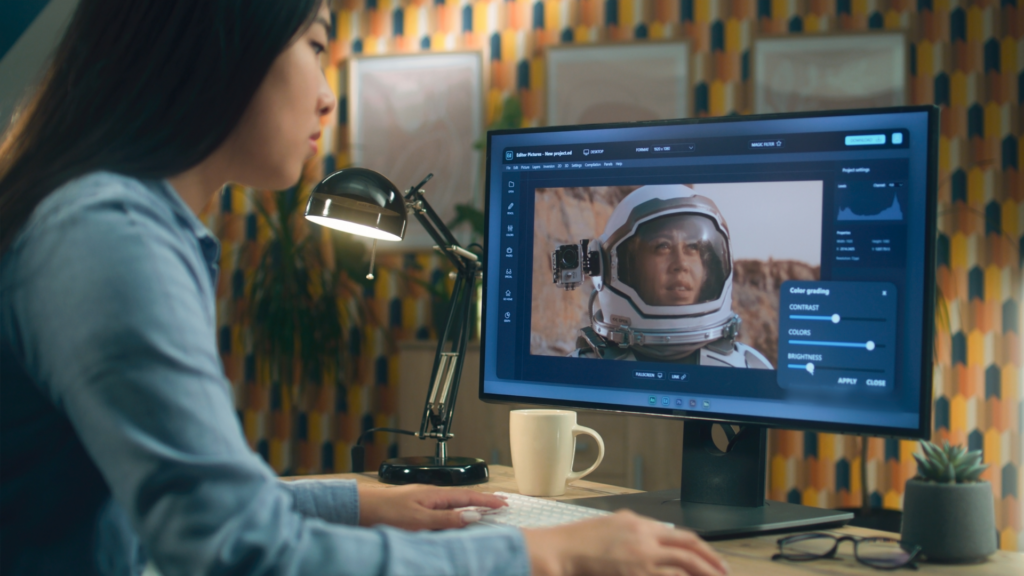Sharing your Skills with a Learn Photoshop Online Business
For experienced Photoshop users, teaching others your photo editing skills online can become a lucrative side business or full-time endeavor. This comprehensive Learn Photoshop Online Business guide covers critical strategies for launching an online Photoshop education company.
Understanding Your Target Student: Learn Photoshop Online Business
The prime demographics interested in developing their Photoshop skills include:
– Amateur photographers – Aspiring hobbyists learning photo editing to elevate their craft.
– Photography students – High and college students looking to improve photos for portfolios and class projects.
– Aspiring graphic designers – Those wanting to master Photoshop for careers in design.
– Working creative professionals – Designers, social media managers, and bloggers needing to polish their skills.
– Small business owners – Entrepreneurs editing images for websites, ads, and social media.
– Career changers – People interested in a career pivot to graphic design or photography.
– Retirees – Older adults pursuing creative hobbies and lifelong learning.
Catering your educational content and messaging to these groups forms a solid student base.
Choosing an Online Teaching Platform: Learn Photoshop Online Business
The right platform for delivering online Photoshop instruction should offer the following:
– Screensharing video – For quickly demonstrating software tools in real-time.
– Interactive whiteboard – To sketch concepts visually together.
– HD video chat – For clear live communication and critique.
– Cloud doc sharing – For providing lesson resources simply.
Given these needs, top options include:
– Zoom – Leading video conferencing platform with screen sharing and whiteboard.
– Google Meet – Free video chat with screensharing built into Google Workspace.
– Whereby – Browser-based video rooms with whiteboard and music capabilities.
– Teachable – Online course creation platform with video, quizzes, and community tools.
A customized website built on common CMS platforms like WordPress or Squarespace can also work with embedded conferencing and membership tools.
Structuring Effective Online Photoshop Lessons

Well-paced virtual Photoshop lessons include:
– Introduction and objectives – Summarize topics and goals for the session.
– Software overview – Refresh tools, panels, preferences, etc. as needed.
– Demonstration – Walk through new techniques step-by-step while screensharing.
– Guided practice – Have students apply concepts to their projects as you observe.
– Q&A – Pause for questions and clarify based on common points of confusion.
– Independent practice – Assignments to reinforce skills between lessons.
– Recap and preview – Quick summary of the lesson and what’s next.
Keeping lessons highly visual and hands-on will best educate students. Share supplemental resources via email or your website.
Valuable Supplementary Content
Besides live lessons, online learning content like:
– Video tutorials – Record screencasts walking through tools and techniques without narration.
– Cheat sheets – Create illustrated guides to shortcuts, effects, and layouts as handy references.
– Webinars – Host live group workshops teaching specialty topics like photo restoration, collage, typography, etc.
– Q&As – Release videos addressing common student questions about everything from layers to workflows.
– Photo packs – Provide sets of images for students to practice editing independently.
– Competitions – Post photo assignments and feature standout student work.
– Quizzes – Solidify knowledge with interactive quizzes testing concepts.
– Office hours – Offer weekly open times for getting quick help between lessons.
This content amplifies learning and builds community among your students.
Promoting Your Learn Photoshop Online Business
Raising awareness for your online Photoshop teaching business requires outbound marketing, including:
– Website – Create an online portfolio showcasing your creative skills, credentials, services, and booking.
– SEO – Optimize website content around keywords like “Photoshop lessons” and “learn Photoshop online” to attract local searchers.
– Social media – Post examples of your editing work on Instagram and TikTok using relevant hashtags like #Photoshop and #photoediting to gain followers.
– Paid ads – Run Google, Facebook, and Instagram ads promoting your classes targeted locally and to photography interests.
– Photography forums – Introduce yourself and offer free tips on forums like Reddit’s r/photography and photographytalk.com to gain clients.
– Local outreach – Share offers for intro Photoshop lessons with college art departments, camera shops, design firms, etc.
– Partnerships – Partner with photographers and influencers to co-create edited photos and videos showcasing your skills.
– Referral incentives – Motivate students to share their classes with friends for discounts or bonus lessons.
Persistently sharing samples of your work and touting your knowledge establishes credibility and attracts new learners over time.
Monetizing Your Learn Photoshop Online Business

There are multiple effective ways to generate revenue from Photoshop instruction, including:
– Hourly lessons – Charge per 30-minute or 1-hour session. $20-$50 per hour is typical.
– Monthly memberships – Offer discounted rates for buying lesson packages each month. Build retention.
– Group classes – Hold webinars and small group sessions at lower rates per student.
– Digital products – Sell your specialized tutorials, templates, and brushes as downloads.
– Merchandise – Create and sell apparel, phone cases, mugs, etc., with your brand and designs.
– Contract work – Provide Photoshop services like editing photos and designing graphics freelance.
– Affiliate marketing – Earn commissions promoting Photoshop-related products and services.
– Advertising – Monetize a blog or videos with display ads like Google AdSense.
Mixing one-on-one teaching with scalable offerings like digital goods and passive income streams maximizes earning potential.
Overcoming Challenges of a Learn Photoshop Online Business
Teaching Photoshop online comes with inherent challenges, including:
– Scheduling – Use scheduling software like Calendly to let students book lessons 24/7.
– Technological issues – Have backup plans if video or internet fails during a lesson. Be flexible.
– Mixed skill levels – Survey students ahead of time to assess abilities and tailor pace.
– Getting unstuck – When students get frustrated, patiently show multiple approaches to get comfortable.
– Preventing cheating – Use small class sizes, personalized assignments, and quizzes to hold students accountable.
– Staying current – Continuously expand your skills and monitor Photoshop updates to remain relevant.
– Tax prep – Consult an accountant to ensure you file any required 1099s for independent teaching income.
With preparation and commitment to providing an excellent learning experience, these hurdles can be overcome to teach Photoshop online.
For creative professionals, becoming an online Photoshop instructor allows you to turn your software skills into a profitable business while helping aspiring designers elevate their work. With the right mix of technical know-how and teaching ability, this niche offers significant income potential. Be sure to continually expand your value through highly visual lessons, valuable supplementary content, and student community building for maximum success.
Key Sub-Niches Within the Learn Photoshop Online Business Teaching Niche

While Photoshop skills open up many creative possibilities, focusing instruction on particular sub-niches can help attract the right students. Here are some of the most lucrative Photoshop teaching sub-niches to consider:
Photoshop for Photographers
Catering to photographers wanting to polish images. Includes:
– Teaching adjustments like exposure, white balance, vibrance, and tone for optimal photos.
– Working with layers for non-destructive editing and complex effects.
– Mastering selection tools for precision editing and compositing.
– Learning to retouch blemishes, smooth skin, and whiten teeth/eyes for portraits.
– Applying filters like tilt-shift, HDR, and vignette for stylistic effects.
– Developing efficient workflows tailored to types of photography like products, real estate, and travel.
Photoshop for Graphic Design
Targeting aspiring designers learning to manipulate imagery. For example:
– Creating composites seamlessly blending multiple stock assets.
– Using layer effects like opacity, shadows, and glows for dimensional illustrations.
– Building complex shapes with vector tools.
– Stylizing photos to have painted, sketchy, or distressed artistic looks.
– Mocking up professional designs with mockups, scenes, and textures.
– Preparing and exporting production-ready files for digital, print, and merchandise.
Photoshop for Social Media
Teaching marketers and influencers visual strategies. Like:
– Creating eye-catching graphics for platforms like Instagram, YouTube, and Pinterest.
– Designing templates and overlays for a cohesive account aesthetic.
– Producing attention-grabbing quotes, graphics, and split images optimized for each network.
– Sizing and editing photos for seamless mobile display.
– Adding stylish filters, textures, light leaks, and shapes for trendy effects.
– Crafting branded visuals, including logos, banners, thumbnails, and more.
Photoshop for E-commerce
Assisting online retailers with product images. Includes:
– Shooting quality product photos suitable for web use.
– Clipping photos and removing backgrounds for isolated products.
– Retouching to correct lighting, smooth surfaces, remove dust, etc.
– Creating consistent image sets with layers and batch processing.
– Building scene composites and mockups for lifestyle product images.
– Producing special effects like reflections, shadows, and motion for modern styles.
Photoshop instructors can better attract and serve students focused on mastering specific skills tailored to their industries and interests by specializing within one of these sub-niches.
Photoshop Sub-Niches by Skill Level
Teachers can also niche down by student ability level, adjusting the learning curve accordingly:
Absolute Beginners
– Navigating the interface – panels, tools, menus, preferences.
– Basic photo edits – brightness, contrast, cropping, resizing.
– Intro selection and layer techniques.
– Following step-by-step tutorials.
Intermediate Students
– Masking, compositing multiple images.
– Color correction, retouching people.
– Working with brushes, filters, gradients.
– Developing independent workflows.
Advanced Learners
– Complex composites, precision selections
– Advanced color correction for subtle fixes
– Custom brushes, layer styles, actions
– Photo restoration, mood matching
Expert Creators
– Illustration from photo manipulation
– Cinematic color grading and tone mapping
– Animating with video timeline
– 3D, VR and experimental techniques
Catering your curriculum to the skill level ensures students are challenged while avoiding frustration.
Sub-Niches by Goal
You can also niche programs by end goals:
Career Building – Portfolio prep for design roles
Artistic Development – Expanding creative capabilities
Business Marketing – Optimizing online visuals
Photo Enhancement – Studio polish for emerging photographers
By aligning courses to objectives, you can attract motivated learners who want to master Photoshop to achieve specific career and passion project goals.
Specializing your online Photoshop instruction makes you more visible to students seeking particular knowledge. However, coupling niche skills with versatile core techniques builds the most vital creative abilities.
Here is some additional market research on the scope and popularity of the online Photoshop learning niche:
Additional Market Research on the Learn Photoshop Online Business Niche
As visual content explodes online, demand for Photoshop skills continues to rise. Relevant statistics include:
– The global e-learning market size was valued at $257 billion in 2022. As remote education expands, it is projected to grow by over 11% CAGR through 2030. Photoshop courses fall under the high-growth creative skills segment.
– Over 9 million students currently use Photoshop regularly, according to Adobe. However, most are self-taught and hungry for structured learning.
– A 2021 LinkedIn Learning report showed “Adobe Photoshop” ranked #2 in skill demand from employers, underscoring its value for careers. “Image Editing” also ranked highly.
– On platforms like Udemy, best-selling Photoshop course topics include photo editing, graphic design, social media graphics, photo manipulation, and retouching – aligning to key sub-niches.
– Photoshop tutorials and training videos generate over 27 million monthly Google searches, showing massive demand for learning visual effects, compositing, color correction, and more.
– The highest demand for Photoshop education comes from India, the United States, Brazil, Canada, and the United Kingdom – major tech hubs and youthful markets.
– Small group Photoshop classes with 5-8 students can command around $100 per student for a 6-week course, providing solid revenue.
– Top instructors charge over $100/hour for private Photoshop lessons, with pro photographers and designers willing to pay premium rates for specialized knowledge.
The data confirms a growing global demand for online structured Photoshop education, particularly courses that provide career value.
Here are approximately 50 broad keywords that define the Learn Photoshop Online Business teaching niche, along with 50 related long-tail keywords:
Broad Keywords:
Photoshop lessons (22K searches), learn Photoshop (18K), Photoshop training (18K), Photoshop tutorial (12K), teach Photoshop (8K), Photoshop teacher (8K), online Photoshop classes (6K), Photoshop course (6K), Photoshop certification (5K), Photoshop tools (4K), Photoshop effects (4K), Photoshop filters (3K), layers Photoshop (3K), Photoshop brushes (2K), Photoshop collage (1K)
Long-Tail Keywords:
Photoshop for beginners (5K searches), intermediate Photoshop tutorial (1K), advanced Photoshop effects (1K), Photoshop for photography editing (5K), Photoshop for graphic design (2K), Photoshop for social media (1K), architectural Photoshop rendering (300), automotive Photoshop rendering (300), best Photoshop courses on Udemy (150), teaching Photoshop online free (100), how to learn Photoshop fast (300), easy Photoshop tutorials step by step (300), Photoshop lessons for high school students (70), teaching Photoshop basics remotely (100), creative Photoshop skills employers want (70), photo manipulation techniques in Photoshop (2K), cinematic color grading in Photoshop (300), sell Photoshop actions online (70)
This covers high-level terms related to Photoshop education and more targeted long-tail keywords, digging into specific skills, techniques, industries, and teaching topics. These keywords provide ideas for structuring lessons and promoting courses.
Need More Technical Online Business Ideas?
Online Degree: Online Business Ideas
Conclusion: Launching a Profitable Learn Photoshop Online Business
For creative professionals, teaching Photoshop skills online is a rewarding way to share your expertise while earning income. Essential tips covered in this guide include:
– Identifying your target students – photographers, designers, marketers, students, and hobbyists seeking to elevate their visual skills.
– Using an interactive platform like Zoom to demonstrate software techniques.
– Structuring lessons to include learning goals, instruction, practice, and assignments.
– Supplementing with valuable resources like video tutorials, cheat sheets, and photo packs.
– Promoting through SEO, paid ads, partnerships, referrals, and student results.
– Offering individual lessons, memberships, group classes, digital products, and contract work.
– Specializing within sub-niches like photo editing, graphic design, and social media graphics based on your strengths.
– Catering approach and curriculum to student skill levels for the proper challenge.
– Being patient with the learning curve and technological hurdles of teaching online.
With preparation and persistence, you can build a thriving online Photoshop education business that attracts eager new creatives.
Additional Tips for Getting Started with Your Learn Photoshop Online Business
Here are some additional tips not covered earlier to help you launch your online Photoshop teaching successfully:
– Invest in pro screen recording software like Camtasia for crisp tutorial videos. Use an HD webcam for clear live video.
– Create a website, social media channels, and branded graphics to appear professional.
– When starting, offer discounted bundles of 5-10 lessons to secure student commitments.
– List your classes on aggregator sites like Skillshare and Udemy for added platform visibility.
– Shoot promotional videos highlighting student creations and reviews to attract signups.
– Guest posts free tips on design and photography blogs to get brand exposure.
– Stay informed by sending students regular quick tutorials and design inspirations via email or text.
By persistently producing value for students at every stage, you can build a recognizable online Photoshop teaching brand that leads to steady growth and referrals. Lean on your creativity and passion for the software to share rewarding skills.
Here is an FAQ covering common questions about building an online business teaching Photoshop:
FAQ for Starting an Online Photoshop Teaching Business

Q: What software do I need to teach Photoshop online?
A: A video conferencing platform like Zoom and a screen recording program like Camtasia to capture your Photoshop screen.
Q: How much should I charge for online Photoshop lessons?
A: Between $20-$50 per hour for individuals is typical based on your expertise level. Bundle deals offer savings.
Q: What equipment is required to teach Photoshop virtually?
A: A laptop or desktop with Photoshop installed, a webcam, microphone, and, optionally, a drawing tablet.
Q: How do I get my first Photoshop students?
A: Offer friends discounts, promote on social media, run local ads, guest post free tips, and partner with photographers.
Q: What qualifications do I need to teach Photoshop?
A: No formal qualifications are necessary. Showcase your skills through an online portfolio of designs and edits.
Q: What should I include on my Photoshop teaching website?
A: Your bio, portfolio, offerings, pricing, platform, contact form. Establish your expertise.
Q: Can I teach Photoshop full-time as a business?
A: Yes, experienced instructors can earn a full-time income through individual and group lessons, digital products, and more.
Q: What curriculum topics should I cover?
A: Provide a mix of beginner tool overviews, photo editing workflows, artistic effects, graphic design projects, etc.
Q: How do I stay up to date on new Photoshop features?
A: Review Adobe’s release notes, attend conferences like Adobe MAX, follow influencers, and continuously expand your skills.
